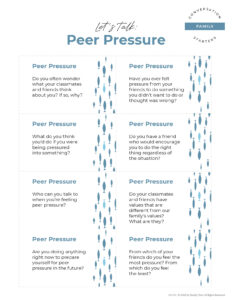“Can Andrea come over?” my 12-year-old asked. I said yes without hesitation. In our old neighborhood, the girls often played together, bonding over fairy books and Barbies. However, after we moved across town, they lost touch for four years until middle school algebra put them together. Unfortunately, 30 minutes into the hangout, I wanted to call it over.
The differences in the girls’ household rules and behaviors quickly become apparent. While the girls made cookies, I overheard a few stories from Andrea that raised my eyebrows. Plus, Andrea, already an avid social media user, insisted on recording everything, mimicking the behavior of influencers. My internal mommy alarm went off, and I realized I didn’t want to encourage this relationship to grow. If your teen’s friendship raises red flags, use these 6 tactics to navigate the situation with grace and wisdom. (Psst! If your child’s not quite a teen, try a little nuanced response.)
1. Understand your discomfort.
At some point, your tween may gravitate toward a person you’d never hand-select for his friend. However, it’s important to pause and discern why you’re bothered by the relationship. Be open to the possibility that your initial reaction to your teen’s friendship might be colored by your own perceptions. Are your concerns rooted in personal biases or past experiences? Is it a gut feeling or a personality clash? Or do you spot red flags, such as bullying, vaping, or misaligned core values? Understanding the root of your discomfort allows you to approach the situation with a clear perspective.
2. Learn more about your teen’s friendship.
For some reason, your tween finds the friendship worthy, and as her mom, that’s worth exploring. Ask her what she likes about this friend. How does she feel when they hang out together? What qualities make her a good friend? Ask questions without judgment and with the intent to understand your child and the friendship better. You might uncover qualities you didn’t pick up on initially or you might learn your tween feels lonely and settled for a less-than-ideal friendship.
3. Get to know the friend better.
Take the extra step to get to know the friend, too. For example, offer to drive them to the movies or order a pizza as a study-break snack. (And be in the kitchen when they eat.) Use those moments for brief, no-pressure touchpoints to learn more about the friend’s interests, family life, or even the types of music or books she gravitates toward. Scroll through her social media accounts, too. You might discover your initial response is spot-on and your tween is being drawn into a bad crowd. Or you may find out that you were wrong.
4. Talk about your concerns with your child.
Look for a calm moment for an open conversation. Treat this as a continuation of an ongoing talk about your teen’s friendship. Share your feelings, observations, and reservations without blaming or criticizing her friend directly. For example:
What not to say: “I don’t like your friend. She posts too many TikTok reels that seem to be all about getting the attention of guys.”
Say this instead: “I noticed your friend seems to put a lot of emphasis on chasing guys. What do you think about that? Is that a priority of yours, too?”
Keep the discussion going with open-ended questions, such as:
- “Have you ever been in a situation with her where you felt uncomfortable or upset? What happened?”
- “How do you feel when she…?” (Tip: Mention a specific behavior you observed.)
- “Have you ever felt pressured to do something you didn’t want to do?”
Consider these additional questions about peer pressure.
5. Set boundaries, if necessary.
It’s crucial to establish clear boundaries, especially if your concerns stem from specific behaviors or activities. Boundaries can include how often your kid hangs out with her friend and where. Setting boundaries isn’t about controlling your teen’s friendships but rather putting in guardrails to guide her. Be firm yet empathetic, explaining the reasons behind the boundaries you’re setting.
Remind your teen which behaviors are acceptable and unacceptable in your family and how they’re connected to your value system. Discuss how to (and whether to!) maintain friendships with people who don’t adhere to the same belief system. It’s also never too early to teach your tween or teen what to say if a friend crosses a boundary.
Remind your teen which behaviors are acceptable and unacceptable in your family and how they’re connected to your value system. Discuss how to (and whether to!) maintain friendships with people who don’t adhere to the same belief system. Click To Tweet6. Coach your child to find her friend group.
Who am I? While your teen won’t ask that question out loud, she is no doubt trying to figure out the answer. Identity formation starts to gain steam during the tween years and carries on through early adulthood. It’s why you may find your child trying out different styles of dress, pushing the limits on language, or all of a sudden listening to French pop music.
Tweens and teens also may go through a phase of experimenting with different friend groups and grow apart from long-time childhood friends. Support your child’s process by encouraging her to explore different social circles and discover where she feels most comfortable. Emphasize the importance of shared values, trust, and positive peer influence. By empowering your child to choose friends, you’re helping her develop essential life skills for building healthy friendships.
How do you strike a balance between respecting your tween’s autonomy and setting healthy boundaries in her friendships?











